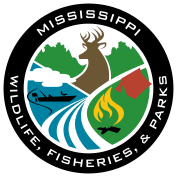
MMNS Aquatic Invertebrate Collection
The Mississippi Museum of Natural Sciences' aquatic invertebrate collection holds specimens from around North America, with an emphasis on specimens from Mississippi, Alabama, and Louisiana. The MMNS Freshwater Invertebrate Collection can be separated into two collections: freshwater mollusks (mussels and snails) and crustaceans (crabs, crayfishes, and shrimps). What is an invertebrate? Simply put, invertebrates are animals that do not possess a vertebral column or backbone. In fact, invertebrates don't have any bones at all. Yet, these animals are incredibly diverse in appearance and can be found in almost any habitat imaginable on earth.
The core of the holdings are collections from MMNS biologists (1990s-present) including Paul Hartfield, Bob Jones, Scott Peyton, Todd Slack, and Matt Wagner. Some of the earliest specimens within the collection start during the WPA (Works Progress Administration) period in the 1930s; however, the foundation of much of our historical knowledge was acquired in 2007 from Tulane University professors notably Drs. George H. Penn, Joesph F. Fitzpatrick Jr., and Royal D. Suttkus during the periods of the 1950s-1980s.
The mollusk collection, which has been completely geo-referenced, consists of ~17,000 specimen lots (88,000 individuals) of 164 bivalve and 36 freshwater gastropod taxa. The majority of specimens (96%) are bivalves. Much of the collection is from Mississippi (87%), but there are specimens from 16 other states as well. The majority of specimens are stored as dry shells, but there are also specimens stored in 70% and 100% ethanol. The latter includes 56 taxa which have been preserved for genetic analysis.
Within the crustacean collection are greater than 10,000 specimen lots representing over 93 species of crabs, shrimps, and crayfishes (~60,000 individuals). The vast majority of the holdings within the crustacean collection are freshwater crayfish (>9,000 specimen lots), making MMNS of the largest collections of crayfish in the world. The crustacean collection contains specimens from 37 states and 17 countries, but the majority (>95%) are from Mississippi, Alabama, and Louisiana. Crustaceans were identified primarily by the late Dr. Joseph F. Fitzpatrick Jr. of the University of South Alabama and Tulane University and the recently retired curator Robert L. Jones at MMNS. The collection also maintains a tissue collection from a portion of our vouchered specimens which are available upon request.
Significant Holdings
- 45 species and 4179 individuals of state and/or federally listed mollusks.
- 18 lots of the formerly extinct and rediscovered Big Black Rocksnail (Lithasia hubrichti).
- Secondary type specimens of 52 crayfish species and 1 freshwater mollusk.
- Collections of the Endangered Benton County Cave Crayfish (Cambarus aculabrum) and Nashville Crayfish (Faxonius shoupi)
Current Focus
- Document distribution of freshwater mollusks in Mississippi.
- Document distribution of crayfish in Mississippi.
- Understand crayfishes preferred habitats and threats.
- Learn about crayfish behavior and life history.
Crayfish and Freshwater Snail Backlog
If interested, we have uncatalogued crayfish and freshwater snail lots from various states (listed below) available to qualified researchers to identify. These lots were gifted to MMNS from Tulane in 2007. Theses collections were made between 1950-1990 by Tulane Professors Drs. George H. Penn and Royal D. Suttkus. We welcome those with the interest and expertise to come to our facilities so we may be able to unlock valuable historical information on crayfish and snail distributions.
- Louisiana = 898 lots (Crayfish), 300 lots (Snails)
- Arkansas = 350 lots
- Georgia = 204 lots
- Oklahoma = 125 lots
- Florida = 76 lots
- Tennessee = 67 lots
- Alabama = 63 lots (Crayfish), 400 lots (Snails)
- Virginia = 51 lots
- North Carolina = 44 lots
- Kansas = 38 lots
- Missouri = 17 lots
- New York = 6 lots
- South Carolina = 1 lot
Links of Interest
View a free PDF Guide to Freshwater Mussels of Mississippi.
View a list of decapod species stored within the collection.
View a list of crayfish paratypes stored within the collection.
Access to the collection by qualified researchers is normally available from 8:30am - 5pm, Monday-Friday. Please contact associated curators to arrange a visit.
Contact (mussels): Robert Ellwanger at Robert.ellwanger@mmns.ms.gov
Contact (crustaceans and gastropods): Calvin Rezac at Calvin.rezac@mmns.ms.gov